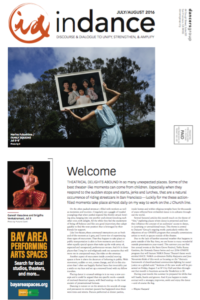 Theatrical delights abound in so many unexpected places. Some of the best theater-like moments can come from children. Especially when they respond to the sudden stops and starts, jerks and lurches, that are a natural occurrence of riding streetcars in San Francisco—luckily for me these action-filled moments take place almost daily on my way to work on the J Church line.
Theatrical delights abound in so many unexpected places. Some of the best theater-like moments can come from children. Especially when they respond to the sudden stops and starts, jerks and lurches, that are a natural occurrence of riding streetcars in San Francisco—luckily for me these action-filled moments take place almost daily on my way to work on the J Church line.
On the often packed streetcar—filled with workers as well as mommies and tourists—I regularly see a gaggle of tousled younglings that when jostled respond like freshly struck bowling pins, banging into one another and almost knocking each other over, with delight. All the while they feel the excitement of being off-balance and like any good improviser, they adapt quickly to find the next position that is leveraged by their friends for support.
Like live theater, these communal interactions are as fresh and of-the-moment as it gets, and I never tire of experiencing these types of encounters. That they happen to take place on public transportation is akin to how moments are shared in other equally special spaces that make up the wide array of, expected and unexpected, performance venues. And it’s in these places that I long for and religiously seek out scenarios that will move me in unexpected ways, like rides on the streetcar.
Another aspect of encounters inside crowded moving spaces is how it alters the decorum of behaving in public. With movement, sudden or not, comes change, and it’s in this situation that I often see happily flushed faces that invariably put a smile on my face and set up a renewed bond with my fellow travelers.
Placing dance in unusual settings is in no way a new concept and it could be argued that site specific work—outside of enclosed theatrical spaces, with fixed seating—is the most ancient of presentational formats.
Dancing in nature or on the streets to the sounds of songs and percussion to entertain passers has happened since there were trees and streets. Dances performed at dinner parties, inside homes and within religious temples have for thousands of years reflected how embedded dance is in cultures through-out the world.
Several featured articles this month touch on the theme of “Site,” exploring places where dance is presented and how they influence the concept of an audiences’ access to dance, in surprising or untraditional ways. This theme is central to Dancers’ Group’s ongoing work: particularly within the objectives of our ONSITE program that annually commissions artists to work in spaces outside of the theater.
Due to the lack of harsher seasonal weather that happens in parts outside of the Bay Area, we are home to many wonderful outside presentations year-round. This summer you can find free annual events at the Stern Grove Festival, Yerba Buena Gardens, the Rotunda Dance Series and our 2016 ONSITE program that will feature NAKA Dance Theater’s latest work entitled RACE. NAKA co-directors Debby Kajiyama and Jose Navarrete think of this work as focusing on the “thematic framework of disenfranchised communities fighting for social justice on a global scale.” Sections of the new work will be presented on Friday, August 5 at SF City Hall and then through-out that month in locations across the Tenderloin in SF.
During your travels this summer be prepared for shifts that will hustle, bustle and groove. And if you happen to make contact with a stranger, improvise, smile and enjoy the dance—and of course the fog.

